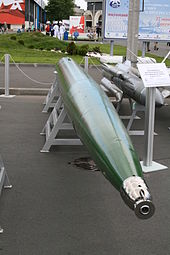torpedo
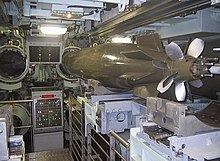
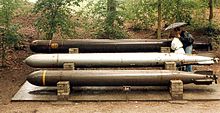

The modern torpedo is an underwater weapon with its own propulsion and an explosive charge. It ignites on contact or when approaching a target. The torpedo is best known as the main weapon of submarines , but it can also be used by surface ships , aircraft and helicopters and fired from land. In addition to submarines, it was used primarily on torpedo boats and torpedo bombers , but destroyers and sometimes even cruisers and battleships were equipped with torpedoes. There are also special sea mines that fire a torpedo. The launch usually takes place from so-called torpedo tubes . Airplanes, helicopters and small torpedo speedboats drop special torpedoes even without such starting aids.
Torpedoes are classified according to their diameter in either the inch (″) or centimeter (cm). Sizes of 17–22.5 ″ (approx. 43–57 cm) are common. In the German navy there were four sizes 35, 45, 50 and 60 cm until the end of the First World War . The German navy used only a diameter of 53.3 cm (21 inches), for aerial torpedoes 45 cm for sea-going vessels from the 1927th Today's torpedoes usually have a diameter of 53.3 cm, torpedoes for anti-submarine defense are 30–40 cm. The length and combat weight of the torpedoes vary greatly. But they are always several meters long and usually weigh more than a ton. Torpedoes for anti-submarine defense are, however, considerably lighter at around 300 kg.
Torpedoes can form part of other weapon systems . Thus, the Mark-46 -Torpedo the NATO z. B. the warhead of the ASROC rocket, which is used against submarines, and is also fired by the Mark 60 CAPTOR marine mine . The most widely used torpedo that can only be launched from submarines is currently the US Mark 48 . In the new German submarines of class 212 A is DM2A4 hake used.
Word origin
The Latin word “torpedo” means “ electric ray ” and is also the scientific name of this species of fish. The Latin term is an education to “torpére”, which can be translated as “to be stunned”. This name has nothing to do with the shape of the weapon, but with the fact that electric rays can deliver "paralyzing blows".
In marine parlance, the term was first used by the American engineer Robert Fulton , who used it in 1800 in connection with his submarine Nautilus for a towed explosive charge that could attack ships from below.
The word torpedo came into common usage, meaning to destroy.
history
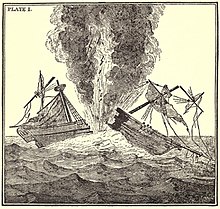
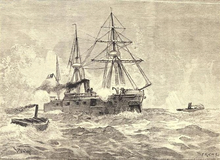
The term “torpedo” was initially used in a very undifferentiated manner as a term for all possible explosive charges in the water, including sea mines . The well-known quote “ Damn the torpedos! Full speed ahead! ”(German:“ To hell with the torpedoes! Full speed ahead! ”) By David Glasgow Farragut , which has been handed down from the battle in Mobile Bay , on mines and not on torpedoes in today's sense. Robert Fulton mentions early attempts in his book Torpedo war, and submarine explosions , in which on October 15, 1805 the ship Dorothea was blown up in two by torpedo attempts and sank within twenty seconds. In the broadest sense, the spar torpedo can be seen as the forerunner of what is now understood as a torpedo . During the Civil War , they looked for a way to overcome ship armor by bringing a large explosive charge directly to the enemy ship using a bar (spar). The functional principle corresponded roughly to that of the petard . The first submarine to use a spar torpedo was the CSS Hunley , which sank the USS Housatonic of the Union Forces on February 17, 1864 . The Hunley sank after the attack, however, for unknown reasons.
The first screw-powered torpedoes were designed and built by Giovanni Luppis , an Austro-Hungarian naval officer. The screw was operated by spring force, and steered with cables from land. The presentation took place in 1860 in Fiume on the northern Adriatic in today's Croatia .
The so-called Whitehead torpedo, which was named after its builder, the English engineer Robert Whitehead , is considered to be the model for the principle and structure of modern torpedoes . Whitehead developed the torpedo for the Austrian Navy together with Luppis and demonstrated it in Fiume in 1866. This torpedo carried a 9 kg explosive charge in the tip, had a range of 300 to 400 meters and reached a speed of 6 knots . The energy source for the drive was air compressed to 40 kp / cm², which was carried along in a pressure vessel.
In the early designs, the stabilizing fins were pulled into the bow area to compensate for the counter-torque of the drive screw. Because of this characteristic appearance, these torpedoes were also called fish torpedo . Since more modern designs are basically driven by two counter-rotating screws , whose torques cancel each other, they get by with comparatively small control surfaces. In view of the low speeds of the early torpedoes and the need to bring them very close to their target, it was referred to as launching a torpedo, whereas today it is referred to as shooting.
The first successful use of a Whitehead torpedo, in which a ship was sunk, took place in the Russo-Ottoman War on January 26, 1878 in the port of Batum . The Russian torpedo boats Tschesma (a 35 cm Whitehead torpedo was attached with ropes under the keel) and Sinope (the torpedo was shot from a tube that was on a raft attached to the side of the hull) under the orders of Stepan Osipowitsch Makarov sank the Turkish customs steamer Intikbah from a distance of 70 meters.
The development of the self-propelled torpedo led to a new quality in tactical thinking. At the end of the 19th century, fast torpedo boats and destroyers were developed, which in turn greatly influenced the designs and tactics of large warships.
The first torpedoes deployed, called straight-ahead torpedoes, once fired, maintained a straight course until they hit their target or ran out of fuel. A further development is wire control, i.e. by pulling out an electrically conductive connection between the torpedo and the launch site for at least a section of the torpedo path. Modern torpedoes, on the other hand, usually have a combination of their own acoustic sensor ( sonar ) and a remote control, usually via a fiber optic cable .
Drive types
The range and accuracy of independent torpedoes depends largely on their propulsion. In order to supply the energy for the drive propellers, which were only used until the middle of the 20th century, various types of drive were tested at the beginning of development. There have been attempts with spring force, flywheels or cable pulls, but these remained too limited in their possibilities. For a long time, the drive via motors operated by gas expansion (initially by compressed air) turned out to be the most practical. Based on this, there were multiple further developments. Only at the beginning of the Second World War were the first electrically powered torpedoes ready for use.
In the second half of the 20th century, water jet and rocket propulsion were also developed for torpedoes, but these have not yet been able to displace screw propulsion.
Gas drive
The gas drive draws its energy from compressed gas, which drives the propellers either via a piston engine or via a turbine . The exhaust gases are generally expelled through the hollow propeller shaft, rarely also on the torpedo body itself, creating a trail of bubbles that is clearly visible from the surface of the water. These systems are relatively light, simple, and reliable. However, the bubble trail can reveal the torpedo's trajectory and the point of launch. Due to the increasing ambient pressure of the water with increasing water depth, gas-powered torpedoes are hardly suitable for submarine hunting, where the torpedo must also be suitable for greater water depths. Also, all non-inert types of propulsion (in which the energy carrier - in this case the propulsion gas - leaves the torpedo) have the peculiarity that the torpedo loses weight during the march, i.e. either water equivalents of ballast weight have to be absorbed, or an altitude control must be used Weight loss and the change in center of gravity must compensate.
Compressed air
After the first unsuccessful attempts with spring force, self-propelled torpedoes were initially driven by pure compressed air, which acted on special gas expansion motors . In the 19th century, the problem was that pressure vessels and compressors were not so well developed to provide sufficient energy for longer running distances (more than just a few hundred meters). Since gases cool down during expansion, the drives used for pure compressed air torpedoes tended to freeze. To prevent this, seawater was sprayed into the compressed air. This heating of the compressed air also brought an additional gain in performance.
Steam gas

From the end of the 19th century, with the advent of compact internal combustion engines, the pure compressed air drive was developed into the steam gas drive, which, alongside the electric drive, is the most common form of drive for torpedoes. The steam gas drive usually also uses compressed air as the basic drive means, and an additional fuel such as petroleum or decalin serves as an additional energy source . The fuel is mixed with the compressed air in a separate combustion chamber and burned, thereby increasing the pressure and volume (and thus the energy content) of the air or the combustion exhaust gases ("dry preheating" ).
The efficiency was later increased even further by feeding water into the engine, but now for cooling, which in turn caused a volume and thus pressure increase through evaporation ("wet preheating", wetheater ). Japanese torpedoes in World War II used oxygen-enriched compressed air, later even pure oxygen (→ Torpedo Type 93 ) as a compressed gas and oxidizer.
Internal combustion engines
Also technically feasible, but only rarely used in tests, is the injection and combustion of the fuel directly in the engine, so that the drive basically works in a similar way to a diesel engine .
Gas generators
During the Second World War, the Germans tried out various variants of the Walter drive , including a. the use of the gases produced during the decomposition of the hydrogen peroxide in the usual four-cylinder gas expansion engines (type G 7 uk) or in turbines (type G 7 ut).
After the Second World War, torpedoes with gas generators were also built. B. by spraying water on lithium blocks to generate hydrogen as the medium for operating a gas turbine, such as the English Spearfish torpedo .
Electric drive
In the period leading up to World War II, the first electric torpedoes were developed to remedy the problem of the telltale bubble path. They are also more difficult to locate acoustically and can be used at great depths. The first electric motorpedoes were still considerably limited in top speed and range due to the lack of high-performance accumulators. The drive energy initially supplied z. B. lead batteries , but their relatively low energy content, high weight and high maintenance costs were disadvantageous. The German torpedo G7e had to be pulled out of the tubes again and again during a mission to recharge the batteries, and before being fired it had to be electrically preheated to 30 ° C so that it reached its full power. With the advancement of battery technology, more and more powerful battery variants came into use and the differences in performance of the drive systems disappeared. Today, silver-zinc accumulators are the most common type of accumulator for torpedoes. This means that modern torpedoes with electric propulsion (as well as steam gas propulsion) reach speeds of up to about 55 kn (≈100 km / h).
Inner workings of a torpedo: with an axial " shaft tunnel " for the drive shaft
Reaction drive
Research into the reactive propulsion of torpedoes began as early as the end of the Second World War . The reactive propulsion is used today in some torpedo models, whereby both solid and liquid propulsion systems can be used. Reactively powered torpedoes are very fast compared to the other types of propulsion, but usually have a shorter range.
Modern supercavitation torpedoes (see below) can only be technically implemented with a reactive drive, since screw drives could not generate the necessary drive power and would also be ineffective in the vapor bubble surrounding the torpedo. Common rocket propellants are used in reactive propulsion, but research has been conducted into the use of metallic propellants in supercavitation torpedoes. Conceivable would be z. B. a combination of aluminum powder and water or steam. Metallic fuels have a higher energy content and generate a higher specific impulse than fuels based on hydrocarbons or hydrogen. However, the high combustion temperatures and the high erosion load on the drive nozzle from the combustion products are problematic.
Other problems such as control and storage / weapon safety seem largely resolved. In contrast to the conventional torpedo, steering via your own sonar is probably out of the question, and the technical questions should also predominate with wire steering. On the other hand, programmed course control is feasible and, thanks to the speed, can also be implemented.
Manageability
Depth control
The first problem to be solved with the autonomously running torpedoes was the safe compliance with the intended depth. If a torpedo runs too close to the surface, there is a risk of getting into the swell area ( i.e. under the influence of the waves). The lateral offset that may be generated by this can extremely shorten the range, since every course correction by the rudder represents an intervention in the ideal hydrodynamics and brakes the torpedo. When breaking through the surface, air would be sucked in by the screw and the motor would rev up due to the instantaneous loss of resistance. In addition, a torpedo breaking through the surface is easily recognizable by the attacked ship, so that defensive measures can be taken. Therefore it makes sense to shoot torpedoes as deep as possible. However, this increases the risk of missing, i.e. H. of underflowing the target without a hit.
The achievable weapon effect is also important (see below) , which in the case of merchant ships and military units depends, among other things, on the statics of the ship and its armor distribution and specifies the hit zone (in this case the impact height). As a rule, however, a leak far below the waterline is more difficult to seal and the armor of warships is strongest in the area of the waterline.
Pressure gauges are usually used for depth control, which control the depth based on the difference between the internal pressure of the torpedo and that of the surrounding water. Submarine hunting torpedoes, on the other hand, have to run a predetermined search program with changing depths in order to locate their target and then attack independently.
stabilization
There was also the problem of keeping the torpedo on a straight course and balancing the torque of the propeller so that the fuselage does not begin to rotate about its longitudinal axis. Attempts were made to prevent this with moderate success in the first variants by using large, rigid guide fins. Only the use of two counter-rotating, coaxial screws did the torpedo of both screws cancel each other out, the torpedo could now be kept stable just by the center of gravity around its longitudinal axis.
Straight-line stability was also a major problem at first. Originally there was no regulation on this. For each individual torpedo, the rudders had to be adjusted in extensive tests so that the torpedo maintained the direction it was taking. External influences (e.g. swell, waves) could still deflect the torpedo from its direction. Only with the use of the gyroscope developed by Ludwig Obry could a controlled straight-line run be achieved from 1895. The built-in gyroscopes, in conjunction with controllable fins, made it possible to actively compensate for deviations from the direction of fire.
Automatics
The first torpedoes had to be aimed at their target purely as a "straight runner" from the launching platform. Safe hits require precise alignment of the firing vehicle and, based on experience, distances of only a few hundred meters, after the introduction of the gyro controls less than 1 km.
Later it became possible to pre-program a course change after the launch, e.g. B. to be able to shoot several torpedoes from parallel torpedo tubes at the same time, which then run different courses (" torpedo compartments ").
Program runner
Under the pressure of ever better underwater localization, the German navy in particular developed various mechanical automatisms to control submarine torpedoes during World War II so that the attacking boats could hit from as great a distance as possible.
The simplest of these was the so-called area search torpedo or spring apparatus torpedo (FAT), which at the end of a pre-set running distance carried out changes of direction in a predetermined pattern in order to increase its chances of hitting convoy formations . He drove in " zigzag " or loops until he hit something or ran out of energy.
The next development was the so-called position - independent torpedo (LUT), which made it possible to fire on targets that were to the side and theoretically also behind the boat.
Target search
While the first straight runner as well as the program runner were no longer influenced after shooting, procedures were already developed during the Second World War that were supposed to enable the torpedo to steer itself towards the target. Both passive processes (the torpedo only "hears" and controls itself on the sound source, e.g. the screw noise) and active processes (the torpedo itself generates sound waves and controls the echo reflected from the target) were possible.
The first truly self-seeking torpedo on the German side was the acoustically guided G7e T IV "Falke", which was tested in March 1943. One improvement was the so-called " wren " ( G7es TV ), which was used on submarines and speedboats from September of that year. The allied counterpart was the Mark 24 ("FIDO", "Wandering Anne"), which was also available in March 1943 and, in contrast to the "Wren", was developed for dropping planes and for submarine hunting. These first automatic systems were partly mechanical or, from today's perspective, had very limited electronics. Today some torpedoes even have active sonar location and microprocessor-controlled target search programs that enable target tracking in three dimensions and the detection of countermeasures.
Remote control

The very first course control of a torpedo, and thus a projectile, was achieved in 1878/79 with the Brennan torpedo, which glides over a ramp from land into the water, and whose stern drive - with counter-rotating screws - takes place on land by pulling out two tensile steel wires by steam engines . The rudder is controlled by pulling at different speeds, while the depth is automatically controlled to 3.7 m so that a small mast - shining backwards at night - rises through the water surface and remains visible to the shooter on a 12 m high telescopic mast. With a wire diameter of 1.8 mm, a speed of 27 kn (50 km / h) was achieved. The range was up to 1800 m (the wire length much longer), the operator followed the mast with a binocular with electrically operated control levers to fine-tune the winding speed, to steer the torpedo and to deflect it by up to 180 °. It could even hit a ship from the rear. Until 1906, the Brennan torpedo was used by the British for port defense.
Nowadays, the torpedo's course can usually also be influenced from the launching vehicle. So that the torpedo z. B. according to the results of the radar or sonar location of the steering vehicle evasive movements of the target are readjusted. To do this, the torpedo pulls a thin control wire or light guide behind it. This also enables commands such as emergency shutdown and premature detonation to be transmitted to the torpedo - a significant advantage if the torpedo unexpectedly turns and sees your own boat as a target.
Torpedo steering malfunctions and other malfunctions
There are several characteristic malfunctions of torpedo steering. If the depth control fails, the torpedo can come to the surface as a surface runner and continue to run. He is then only able to steer the side to a limited extent, can lose speed and be discovered from the target and possibly fought. The opposite of the surface runner is the basic walker . The torpedo steers downward without braking until it hits the seabed or is destroyed by the water pressure. If a torpedo to be ejected becomes jammed in the tube or cannot come out of the tube for other reasons, it is called a tube runner . This can also occur when the self-propulsion of the weapon becomes active by itself, for example when it reaches a certain diving depth. If an ejection is not possible, the torpedo must be brought into the interior and its drive deactivated by hand.
Upon failure of the page control unit adjust circuit rotor is a considerable risk for shooting the vehicle. When the rotor circuit dysregulation causes the torpedo runs a circle and again the position of the vehicle approaches abschießenden. To counter this danger, modern torpedoes have a safety mechanism that deactivates them when changing course by 180 °.
The safety of the detonators was partly ensured by a protective cap falling off in the water flow. Since the explosion of the torpedo endangers your own ship / boat, detonators are only sharpened after a certain distance or distance.
Weapon effect
The functional principle of the torpedo has remained largely the same to this day, even though modern torpedoes have some more components than early designs. Even today, torpedoes are still cigar-shaped and swim just below the surface of the water when attacking surface ships in order to blast a hole in the ship's side below the waterline and thus make the target sink. This is achieved by percussion fuses , which detonate the explosives in the head of the torpedo.
In the event of an explosion directly on the target, however, part of the explosion pressure is lost in the ship's cavity. This is why distance fuses were developed or the explosive device was moved from the tip further back in the torpedo. The resulting pressure wave in the inelastic water causes the damage to unarmored ships to be considerably greater despite the distance.
Alternatively, one tries to detonate torpedoes under the floor of the target. These were Magneto developed based on the typical changes in the earth's magnetic field react, causing the steel mass of a ship. If the torpedo explodes while undercutting the ship, it is first hit by the pressure wave, then the ship loses its buoyancy at this point due to the expanding gas bubble and breaks apart under its own weight.
At the beginning of the Second World War, both Americans and Germans had problems with the newly developed magnetos and the depth control of their torpedoes. This phase went down in history as the torpedo scandal (USA) or torpedo crisis (Germany).
The respective problems were based on errors in development, production and handling. However, the exact control of magnetos was also extremely difficult to implement with the technology of the time. This led to a large number of failures, especially the submarine weapon of the two navies, and to a temporary abandonment of the newly developed technology.
Technical problems with torpedo safety have also led to serious accidents in recent times. The loss of the Russian nuclear submarine K-141 Kursk on August 12, 2000 is presumably due to a defective torpedo. The same applies to the US nuclear submarine USS Scorpion (SSN-589) , which was most likely destroyed on May 22, 1968 by the malfunction of its own torpedo.
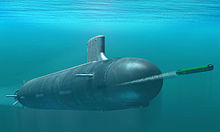
Apart from the depth charge , the torpedo is the only weapon used to actively combat submerged submarines. The attack on a submerged enemy submarine usually takes place at great depth. Modern torpedoes reach water depths of around 750 meters. To locate an enemy submarine that can move in all three dimensions, today's torpedoes have active and passive sonar detectors in their tip. The signals received are evaluated by a computer, which is usually located in the middle of the torpedo, and commands for the control fins at the end of the torpedo to change direction are derived from them. Special warheads have been developed to penetrate the armored double hulls of large nuclear submarines.
In addition to torpedoes with conventional warheads , torpedoes with nuclear warheads have also been built since the Cold War . The USSR in particular hoped to be able to eliminate the US carrier combat groups as effectively as possible in the event of war , as they were clearly inferior to the Americans in this area of maritime warfare, while their submarine fleet was significantly stronger. Some of the nuclear torpedoes were lost or dumped at sea and therefore represent an increasing risk.
Recent developments
The "SeaHake Mod.4 ER" (Extended Range) torpedo from Atlas Elektronik , a further development of the DM 2 A4 of the submarine class 212 A of the German Navy, achieved a new range record of 140 km in 2012 and thus exceeded the range of conventional heavyweight torpedoes by more than 50%.
Since the 1970s, torpedoes with a supercavitation bubble and rocket propulsion by a solid rocket that are at least 200 knots fast have been in use. While the first attempts at jet propulsion took place on the German side during the Second World War, the Soviet navy and weapons technology played the actual pioneering role here. In 1977 she put the first operational super cavitation torpedo ( shkwal ) into service.
According to descriptions and published photos, these torpedoes have a flattened surface at the tip. At the edges of the surface, the actual cavitation bubble forms towards the rear, supported and expanded by the diversion of exhaust gases. The steering is done by the controllable surface at the tip, by side fins and possibly by the jet propulsion itself.
The first Shkwal torpedoes were unguided and intended for conventional and nuclear warheads. Later Schkwal torpedoes and the export model Schkwal E are not target-seeking either; the target data must be programmed into the torpedo's autopilot prior to launch. They have conventional warheads with 210 kg TNT . There are reports of more modern variants of the Shkwal torpedo, which move in search of a target or at least remote-controlled.
Another development in this direction is the German super cavitating underwater barrel from Diehl BGT Defense .
Torpedo defense

Various measures and systems are used to repel enemy torpedoes. During the First and Second World Wars, passive measures were used to protect torpedoes, for example structural features such as the torpedo bulge or torpedo protection nets .
In today's torpedo defense, the ship's own sonar systems are initially used to detect attacking torpedoes.
Various driving maneuvers can be used to attempt to deflect the torpedo. To defend against enemy target-seeking torpedoes, in turn, target-representing counter torpedoes or towing decoys , z. B. the US-American AN / SLQ-25 Nixie , which simulate one or more decoy targets , mostly with a very strong electromagnetic and / or a coordinated acoustic frequency spectrum (to represent screw noise ). Attacking torpedoes then almost always switch to the stronger decoy target (so-called lock on ) and allow the attacked person to temporarily withdraw from the threatening situation. Various decoys that can eject acoustic decoys are also used on board surface units as well as submarines , e.g. E.g. the French system SLAT (Systems de Lutte Anti-Torpille), the British system SSTD (Surface Ship Torpedo Defense) and the German system TAU 2000 ( Torpedo Defense U-Boats).
Various systems, some of which are still under development, are also used to attempt to destroy the attacking torpedo directly. For example, the Russian depth bomb launcher RBU-12000 or anti-torpedo torpedoes are used.
Museum reception

In the Army History Museum in Vienna, in which the history of the Austro-Hungarian Navy is documented in detail, is one of the first torpedoes that was developed by Robert Whitehead in collaboration with the Austrian frigate captain Johann Luppis. It has a length of 3.35 m and a diameter of 35 cm, is considered to be the first functional torpedo in naval history and has been adopted by almost all navies. Other torpedo models are on display in the permanent exhibition, including a cutaway model that is excellently worked out in technical detail.
See also
literature
- Manfred Schiffner, Karl-Heinz Dohmen, Ronald Friedrich: Torpedo armament . 2nd Edition. Military publishing house of the German Democratic Republic, Berlin 1990, ISBN 3-327-00331-9 .
- Edwyn Gray: The Devilish Weapon. History and development of the torpedo . Stalling, Oldenburg / Hamburg 1975, ISBN 3-7979-1858-5 , translated by Hilde Bertsch (original title: The Devil's Device , Robert Whitehead and the History of the Torpedo, Seeley, London 1975 / Naval Institute Press, Annapolis MD 1991; revised and updated edition, ISBN 978-0-87021-245-1 )
- Torpedoes and anti-torpedoes . In: The Gazebo . Volume 2, 1878, pp. 39–40 ( full text [ Wikisource ]).
Web links
Individual evidence
- ↑ Mineman Memories Captor (English) accessed 2018-12-10
- ↑ Robert Fulton: Torpedo war, and submarine explosions . William Elliot, New York 1810, pp. 177 ff. (English) Textarchiv - Internet Archive .
- ↑ Ingo Bauernfeind: Radioactive for all eternity - The fate of the Prinz Eugen . ES Mittler & Sohn, Hamburg / Berlin / Bonn 2011, ISBN 978-3-8132-0928-0 , p. 159 f .
- ↑ Atlas Elektronik sets a new range record for torpedoes ( memento from October 1, 2012 in the Internet Archive )
- ↑ Modern Torpedoes And Countermeasures . ( Memento from February 22, 2012 in the Internet Archive ) Bharat Rakshak Monitor; Retrieved February 9, 2013.
- ↑ SeaSpider - Anti Torpedo Torpedo . ( Memento of January 24, 2013 in the Internet Archive ) Atlas Elektronik, accessed on February 9, 2013.
- ^ Army History Museum / Military History Institute (ed.): The Army History Museum in the Vienna Arsenal . Verlag Militaria, Vienna 2016, ISBN 978-3-902551-69-6 , p. 164









